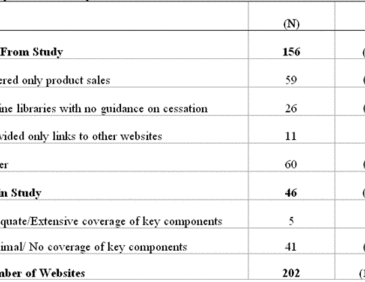During 2002, more than 73 million Americans accessed the Internet in search of health information (Fox & Rainie, 2002). As more people gain access to computers, the Internet is becoming a more viable outlet for doing large scale smoking cessation interventions. The anonymity of e-mail and chat rooms helps people feel more comfortable; thus, they might be more likely to talk to counselors and others about smoking and quitting. The Internet offers convenience by allowing users to move at their own pace when attempting to quit. Bock et al., (2004) recently reviewed and evaluated smoking cessation treatment on the Internet.
Researchers utilized four different search engines to locate smoking cessation websites on the Internet including Google because of its mass appeal. Key search terms included phrases such as “stop smoking,” “quit smoking,” and “smoking cessation.” For the study, they reviewed the first ten pages from each search engine. This strategy identified 202 unique websites. Trained coders using structured instruments assessed the quality of content and usability of these websites. Bock et al. assessed content using the U.S. Public Health Service’s national guidelines, which include items such as assessing readiness to quit, assisting with a quit plan, and many other key components. They assessed usability by following guidelines set out by the National Cancer Institute (www.usability.gov) covering four site aspects: design, reading, navigation, and accessibility.
Researchers excluded websites if they did not provide direct Internet based treatment (77%). For example, websites were excluded that had any of the following: product sales only (29%); online libraries with articles about smoking cessation, but no guidance about quitting (13%); websites that only included a list of links to other smoking cessation websites (5%); advertisements for clinics, political action websites, education written for health care providers, and abandoned websites. After applying all exclusion criteria, the investigators eliminated 156 websites from the analysis (Figure 1).

Figure 1. Categories of smoking cessation Internet websites. Click image to enlarge.
The investigators analyzed the 46 included websites for content, quality, usability, and accessibility. These sites represent only 23% of the total websites found on the first ten pages of each of the four search engines. Consequently, the odds are greater than 3:1 against finding a website that provides even minimal treatment for tobacco cessation. Only 5 (10.7%) of the analyzed websites provided adequate to extensive coverage of the key components laid out by the U.S. Public Health Service (see Figure 2). Approximately two-thirds of the websites had content that was easy or very easy to locate. However, the mean reading level for the websites was grade 8.8, which for many people might be demanding, especially people for whom English is a second language.

Figure 2. The five highest rated websites in terms of coverage, accuracy, and use of interactivity (Bock et al., 2004). Click image to enlarge.
We identified three potential limitations to this study. First, the Internet is a fluid entity, websites are continuously created, destroyed, and updated and the results only reflect the websites available on the day the search was done.
Second, this was not an exhaustive search, but a search limited to the first ten pages of each of the four search engines used. Although it is probably true that most people would give up well before they reach page 10 of any search engine, people with a strong desire to quit smoking might reach beyond page 10 in an attempt to find an appropriate Internet tool to help them quit smoking. Third, due to the breadth of information available on each of these websites, the researchers might have missed some content on each of the websites.
Despite these concerns, the study findings indicate that quality smoking cessation treatment is available on the Internet, but smokers likely will have difficulties distinguishing among the numerous websites. Future efforts should try to improve content to satisfy the guidelines established by the U.S. Public Health Service. Websites should implement technology that interacts with clients and helps them monitor and comply with their smoking cessation therapies. This innovative technology might increase the usefulness and effectiveness of web-based smoking cessation intervention and ultimately help more smokers to quit.
–John Kleschinsky.
References
Bock, B., Graham, A., Sciamanna, C., Krishnamoorthy, J., Whiteley, J., Carmona-Barros, R., et al. (2004). Smoking cessation treatment on the Internet: content, quality, and usability. Nicotine & Tobacco Research, 6(2), 207-219.
Fox, S., & Rainie, L. (2002). E-patients and the online health care revolution. Physician Executive, 28(6), 14-17.
What do you think? Please use the comment link below to provide feedback on this article.




